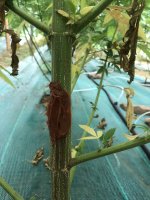Young_Thumb
New member
Hi everyone !
i'm new on this forum so please be gentle and do not hesitate to ask me for more details.
First a quick presentation of my plants
Variety : Sativa
Age of the plants: Blooming W+6
Symptoms appeared : Blooming W+3,5
Contaminated parts : Stem
Evolution of the problem : Slow
Environment : Greenhouse
Kind of soil : Humus-rich
Few weeks ago i discovered that a stem on a plant was feeling deezy. When i looked closely, i saw that the knot of that stem was circled in white and pointed with black little dots.

When i tried to move that stem it broke and remained in my hand?




As the hole was done i did remain properly all the remaining black/browny things around it and apply some mastic.

Two weeks late i feel like de shadow is spreading a bit around. As i do have a plant each square meter, i'm a bit scared wondering if i'd rather cut the whole plant right away i order not to infect the other plants around.

Would appreciate any piece of advice
Many thanks for your help and have a great day !
i'm new on this forum so please be gentle and do not hesitate to ask me for more details.
First a quick presentation of my plants
Variety : Sativa
Age of the plants: Blooming W+6
Symptoms appeared : Blooming W+3,5
Contaminated parts : Stem
Evolution of the problem : Slow
Environment : Greenhouse
Kind of soil : Humus-rich
Few weeks ago i discovered that a stem on a plant was feeling deezy. When i looked closely, i saw that the knot of that stem was circled in white and pointed with black little dots.

When i tried to move that stem it broke and remained in my hand?




As the hole was done i did remain properly all the remaining black/browny things around it and apply some mastic.

Two weeks late i feel like de shadow is spreading a bit around. As i do have a plant each square meter, i'm a bit scared wondering if i'd rather cut the whole plant right away i order not to infect the other plants around.

Would appreciate any piece of advice
Many thanks for your help and have a great day !





 >>> Best >ibes
>>> Best >ibes




